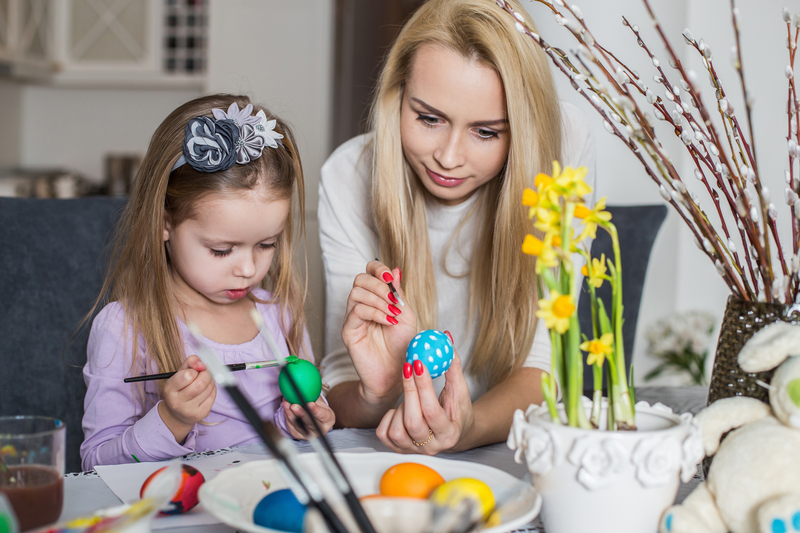Achieving an Allergen-Reduced and Dust-Free Living Space
Posted on 24/09/2025
Achieving an Allergen-Reduced and Dust-Free Living Space
Allergens and dust are common indoor discomforts that can negatively impact your health and home environment. Whether you deal with allergies, asthma, or simply want a cleaner, fresher home, creating a space that minimizes both allergens and dust is essential. This comprehensive, SEO-optimized guide will explore effective strategies, cleaning solutions, product recommendations, and organizational tips for achieving an allergen-reduced and dust-free living space.
Why Is Allergen and Dust Reduction Important?
Dust and allergens can cause more than just sneezing or coughing; for some, they trigger serious allergic reactions, asthma attacks, eczema, and other health challenges. Common indoor allergens include dust mites, pet dander, pollen, and mold, all of which can thrive in seemingly clean homes. By focusing on allergen-reduction and dust-removal strategies, you're creating a healthier home for you and your loved ones.
- Improved Respiratory Health: Cleaner air means fewer triggers for asthma and allergies.
- Better Sleep Quality: Less coughing and sneezing at night for more restful sleep.
- Enhanced Comfort: A fresh, dust-free home feels inviting for everyone.

Main Sources of Allergens and Dust in Your Home
To limit allergens and dust, it's important to identify where these particles originate:
- Textiles: Carpets, rugs, curtains, and upholstered furniture trap dust and allergens.
- Pets: Dander and fur are major culprits, even in homes with "hypoallergenic" breeds.
- Outdoor Pollutants: Pollen, spores, and debris enter through windows, doors, and on shoes.
- Household Activities: Cooking, cleaning, or smoking can release particles into the air.
- Clutter: Excessive belongings collect dust more quickly.
Understanding these sources is the first step towards maintaining an allergen-reduced and dust-free living environment.
Comprehensive Steps to Achieve an Allergen-Reduced and Dust-Free Living Space
1. Establish a Rigorous Cleaning Routine
Routine cleaning is the foundation for diminishing dust and allergens.
- Vacuum Frequently: Use a vacuum with a HEPA filter at least twice a week on carpets, rugs, and upholstery. For severe allergies, consider vacuuming daily.
- Mop and Dust: Dust all surfaces--furniture, baseboards, shelves--using damp cloths or microfiber dusters to trap particles rather than stirring them up. Mop hard floors weekly.
- Wash Fabrics: Wash bedding, curtains, and slipcovers in hot water (at least 130?F/54?C) weekly to eliminate dust mites and their eggs.
Tip: Avoid feather dusters, which only redistribute dust. Microfiber cloths are substantially more effective for picking up and holding dust particles.
2. Control Humidity Levels
Maintain indoor humidity between 30% and 50% to discourage the survival of dust mites and mold:
- Use a dehumidifier in damp spaces like basements.
- Install exhaust fans in bathrooms and kitchens to expel moisture.
- Fix any leaks in pipes or roofs immediately.
3. Upgrade Your Air Filtration
Air purification is a game-changer when it comes to reducing household allergens:
- HEPA Air Purifiers: Place high-efficiency particulate air (HEPA) purifiers in bedrooms and main living areas to capture dust, dander, pollen, and even some bacteria.
- Change HVAC Filters: Replace furnace and air conditioner filters every 2-3 months (or more often if recommended), and select filters with a MERV rating of 11 or higher for the best allergen reduction.
- Keep Air Ducts Clean: Have heating and cooling ducts professionally cleaned every few years to prevent dust buildup and circulation.
4. Minimize Carpets and Upholstered Furniture
Textiles are dust and allergen magnets. Consider the following for a more allergen-reduced, dust-free living space:
- Replace wall-to-wall carpeting with hard flooring like wood, laminate, or tile.
- Opt for leather, vinyl, or tightly-woven fabric furniture instead of plush upholstery.
- If rugs are necessary, choose short-pile or washable options and clean them regularly.
5. Declutter Your Home
Clutter gives dust a place to settle. Reduce clutter in your living areas by:
- Storing rarely used items in closed containers or cabinets.
- Limiting decorations and knickknacks exposed on shelves.
- Organizing children's toys and books in bins that can be wiped down.
A minimal and organized home is much easier to keep allergen-free.
6. Create an Allergen-Reduced Bedroom
The bedroom is a sanctuary--but not if it harbors allergens. To create a restful, allergen-reduced bedroom:
- Use dust-mite-proof covers on mattresses, pillows, and duvet inserts.
- Wash all bedding in hot water weekly.
- Keep pets out of bedrooms to prevent dander buildup.
- Avoid heavy drapes and opt for washable window coverings.
- Keep stuffed animals and other textile items to a minimum, washing them frequently.
7. Control Pet Dander and Allergens
For pet owners, reducing dander is key:
- Bathe pets regularly according to veterinarian guidelines.
- Brush them frequently--ideally outdoors--to remove loose fur and dander.
- Use a HEPA vacuum to clean pet bedding and favorite resting spots.
- Establish pet-free zones, especially bedrooms.
8. Prevent Mold and Mildew
Mold spores are potent indoor allergens. Prevent growth by:
- Quickly repairing leaks in roofs, windows, or plumbing.
- Running bathroom and kitchen exhaust fans during and after use.
- Using a dehumidifier in damp areas.
- Cleaning mold-prone surfaces (e.g., tile, window sills) with mold-killing products.
9. Upgrade Windows and Doors
Keep outdoor allergens and dust from infiltrating your home:
- Install high-quality weatherstripping and seals around doors and windows.
- Keep windows closed during high pollen seasons.
- Change door mats frequently and consider a two-mat system (one outside, one inside) to trap dirt and pollen.
- Ask family and guests to remove shoes upon entering.
10. Smart Cleaning Products for an Allergen-Reduced Home
Not all cleaning methods are equal when it comes to reducing allergens and dust. Here's what to look for:
- HEPA Filter Vacuums: Essential for capturing the smallest allergen particles.
- Microfiber Cloths and Mops: Trap and hold dust better than traditional cotton.
- Non-Toxic Cleaners: Green-certified or fragrance-free products prevent additional irritants from entering your air space.
- Allergen-Reducing Laundry Detergents: Hypoallergenic formulas keep fabrics free from residues.
- Steam Cleaners: Use hot steam to sanitize surfaces, kill dust mites, and avoid harsh chemicals.
Daily and Weekly Allergen and Dust Reduction Checklist
Consistent routines are crucial. Use this simple checklist to stay on top of your allergen and dust control:
Daily Tasks- Wipe kitchen and bathroom surfaces.
- Quick mop of high-traffic hard floors.
- Pet grooming and bedding shake-out.
- Ventilate home by opening windows (if pollen counts are low).
- Vacuum floors and upholstery with HEPA filter.
- Dust surfaces with a microfiber cloth.
- Wash bedding, curtains, and throw rugs in hot water.
- Change or clean HVAC and air purifier filters.
- Declutter living spaces and organize loose items.
Choosing the Right Furnishings and Materials
Your choice of furniture and building materials can have a significant impact on your ability to maintain a dust-free, allergy-friendly home:
- Solid-Surface Flooring: Hardwood, bamboo, vinyl, or tile floors are preferable to carpet.
- Simple Window Coverings: Blinds, shades, or machine-washable curtains are best for limiting dust collection.
- Enclosed Storage: Use closed cabinets and drawers rather than open shelving.
- Metal or Plastic Furniture: These attract less dust than heavily upholstered options.
- Hypoallergenic Bedding: Choose synthetic or tightly-woven materials over down or wool.
Common Mistakes to Avoid in Your Allergen-Reduced and Dust-Free Journey
- Ignoring Hidden Spots: Dust hides on ceiling fans, light fixtures, behind appliances, and under furniture.
- Overusing Scented Cleaners: Many air fresheners and cleaners release potential allergens and irritants.
- Letting Ducts and Filters Go Unchanged: Dirty filters blow allergens back into living spaces.
- Accumulating Clutter: The more you have, the more collects dust.
Long-Term Benefits of Maintaining an Allergen-Reduced, Dust-Free Home
- Healthier Living: Fewer allergy and asthma symptoms, reduced risk of infection, and improved lung function.
- Less Wear and Tear: Dust and dirt act as abrasives, shortening the life of electronics, textiles, and flooring.
- Improved Indoor Air Quality: Cleaner air for everyone, including children and seniors.
- Increased Comfort: Enjoy a more inviting, pleasant, and restful home atmosphere.

Expert Tips for Allergy and Dust Control
- Test for Allergens: If symptoms persist, consider professional allergen testing to identify specific triggers.
- Wash Your Hands Frequently: Especially after being outdoors or handling pets.
- Choose Allergy-Friendly Plants: Select houseplants that don't release pollen or encourage mold.
- Maintain Outdoor Areas: Keep patios, porches, and entryways swept to minimize transfer indoors.
- Work With an Expert: Allergists, HVAC professionals, or green cleaning experts can tailor solutions for your family's needs.
Conclusion: Your Path to a Healthier, Dust-Free Living Environment
Creating and maintaining an allergen-reduced, dust-free living space is an attainable goal. By following the in-depth guidelines detailed above, you'll limit allergen sources, capture airborne particles before they settle, and foster a safer, more comfortable home for all. Take action today--your lungs, sinuses, and overall well-being will thank you!
Ready to begin? Start with one room, build simple habits, and remember: a cleaner home means a healthier you!




